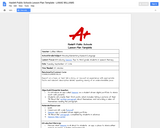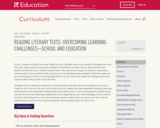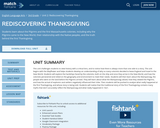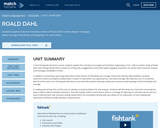
Introducing Seesaw App to third grade students in speech therapy
- Subject:
- English Language Arts
- Speaking and Listening
- Material Type:
- Lesson
- Provider:
- Michigan Virtual
- Author:
- LaNae Williams
- Date Added:
- 03/30/2017

Introducing Seesaw App to third grade students in speech therapy

Meg set out to climb up and investigate the rain forest tree canopies — and to be the first scientist to do so. But she encountered challenge after challenge. Male teachers would not let her into their classrooms, the high canopy was difficult to get to, and worst of all, people were logging and clearing the forests. Meg never gave up or gave in. She studied, invented, and persevered, not only creating a future for herself as a scientist, but making sure that the rainforests had a future as well. The resource includes a lesson plan/book card, a design challenge, and copy of a design thinking journal that provide guidance on using the book to inspire students' curiosity for design thinking. Maker Challenge: Your community has many different areas to explore - it might be a park, a grocery store, a forest, or an alley. For some people, it might be difficult to explore these areas because they may have differing abilities. Select one area in your community, and come up with a plan to build a way for it to be more accessible to everyone.
A document is included in the resources folder that lists the complete standards-alignment for this book activity.

Richard grew up in Kenya as a Maasai boy, herding his family’s cattle, which represented their wealth and livelihood. Richard’s challenge was to protect their cattle from the lions who prowled the night just outside the barrier of acacia branches that surrounded the farm’s boma, or stockade. Though not well-educated, 12-year-old Richard loved tinkering with electronics. Using salvaged components, spending $10, he surrounded the boma with blinking lights, and the system works; it keeps lions away. His invention, Lion Lights, is now used in Africa, Asia, and South America to protect farm animals from predators. The resource includes a lesson plan/book card, a design challenge, and copy of a design thinking journal that provide guidance on using the book to inspire students' curiosity for design thinking. Maker Challenge: Your challenge is to use broken or old technology and other available resources to create a prototype that can be used to protect your home. This could involve tinkering, hacking, or redesigning the components of the technology to meet your needs.
A document is included in the resources folder that lists the complete standards-alignment for this book activity.

The true story of how Momofuko Ando was inspired to create one of the world’s most popular foods after seeing long lines of hungry people waiting for a simple bowl of ramen following World War II. He dreamed about making a new kind of ramen noodle soup that was quick, convenient, and tasty for the hungry people because he believed that peace follows from a hungry stomach. With persistence, creativity, and a little inspiration, Ando succeeded. The resource includes a lesson plan/book card, a design challenge, and copy of a design thinking journal that provide guidance on using the book to inspire students' curiosity for design thinking. Maker Challenge: Develop a food product (a new food, tool, or invention, et al) to help increase access to food in your community.

Tells the story of how the Slinky, the most popular toy in American history, was invented. The resource includes a lesson plan/book card, a design challenge, and copy of a design thinking journal that provide guidance on using the book to inspire students' curiosity for design thinking. Maker Challenge: Develop a commercial about the Slinky.
A document is included in the resources folder that lists the complete standards-alignment for this book activity.

A young girl has a wonderful idea to make the most MAGNIFICENT thing! But making her magnificent thing is anything but easy, and the girl repeatedly tries and fails. Eventually, she quits, but a walk with her dog and time to think, she comes back to her project with renewed enthusiasm and manages to get it just right. The resource includes a lesson plan/book card, a design challenge, and copy of a design thinking journal that provide guidance on using the book to inspire students' curiosity for design thinking. Maker Challenge: Create small groups. Pass out one of the challenges listed in the lesson plan/book card to each group for them to come up with an invention that will solve the problem at hand.
A document is included in the resources folder that lists the complete standards-alignment for this book activity.

Isatou Ceesay observed a growing problem in her community where people increasingly disposed of unwanted plastic bags, which accumulated into ugly heaps of trash. She found a way to be the agent of change by recycling the bags and transforming her community. The resource includes a lesson plan/book card, a design challenge, and copy of a design thinking journal that provide guidance on using the book to inspire students' curiosity for design thinking. Maker Challenge: Use plastic bags to develop a new product (i.e. jump rope).
A document is included in the resources folder that lists the complete standards-alignment for this book activity.

Learning to Write an Opinion (5 days)
Day 1. For this end of year project, you are going to do one last book review, but this time it is going to be in the form of an advertisement. You will share your ads with the 2nd graders as a preview for what they will be reading next year and your goal is to get them excited about 3rd grade reading.
Students will choose their favorite book from the year and begin planning the draft of their advertisement with the checklist as their guide. Offer support to students and coach them about the features of an advertisement.
Book Review Opinion Checklist Sample
Day 2. Yesterday you started the draft of your advertisement and planned out the elements from the beginning of the checklist. Today you will finish your draft using the elements of the checklist as a guide. We will look back at the book review checklist.
Day 3. Today you will need to revise and edit your advertisement and then have a partner revise and edit. Then you will create your final ad with any artwork you want to include. Be sure to think about making a lasting memory for your reader:
-Revise and edit advertisement
-Peer revise and edit
-Create final draft with added artwork
Day 4. Today you will practice presenting your advertisements to a partner.
Review the presentation skills for the presenter and the listener.
Day 5. You will share your advertisements with a lot of 2nd graders today.
Students will present advertisements (and listen and offer feedback or ask questions if their partner is also sharing a review or ad).

With encouragement and ideas from his family, Papa, based on the real-life inventor Lodner Phillips, builds a working submarine that takes his family on a ride to the bottom of Lake Michigan. The resource includes a lesson plan/book card, a design challenge, and copy of a design thinking journal that provide guidance on using the book to inspire students' curiosity for design thinking. Maker Challenge: Students will use materials on hand to design a solution to a problem they see in their school or at home. The invention should meet the needs of fellow students, teachers, bus drivers, principals, siblings, friends, or even parents.
A document is included in the resources folder that lists the complete standards-alignment for this book activity.

ELA G3:M1:U1
READING LITERARY TEXTS: OVERCOMING LEARNING CHALLENGES—SCHOOL AND EDUCATION
ELA G3:M1
ELA G3:M1:U1:L1
In this Unit
Guiding Questions and Big Ideas
The Four Ts
Assessment
Content Connections
Habits of Character
Unit-at-a-Glance
Accountable Independent Reading
Supporting English Language Learners
Texts and Resources to Buy
Preparation and Materials
Technology and Media
Additional Language and Literacy Block
Lessons
Optional Activities
You are here:
ELA Grade 3
ELA G3:M1
ELA G3:M1:U1
Like what you see?
Order printed materials, teacher guides and more.
How to order
Help us improve!
Tell us how the curriculum is working in your classroom and send us corrections or suggestions for improving it.
Leave feedback
In Unit 1, students read literary texts about children who face challenges with access to education. Throughout the course of the unit, students read three literary texts: Waiting for the Biblioburro by Monica Brown, Rain School by James Rumford, and Nasreen's Secret School by Jeanette Winter. They read each text for gist, recount the text, determine its central message or lesson, and then closely read and answer text-dependent questions designed to help them explain how that central message or lesson is conveyed through details in the text. Students also identify the challenges faced by the characters and how they are able to overcome them.
Throughout the unit, students are introduced to routines and anchor charts that will be used throughout the rest of the module, as well as the rest of the year. In the first half of the unit, students learn about independent reading and discussion norms and receive their independent reading journals and vocabulary logs. For the mid-unit assessment, students discuss what they like about their independent reading books and the things that they have found challenging. In the second half of the unit, after learning how to write short constructed responses, students read a new literary text, answer selected response questions, and write short constructed responses about questions having to do with the text.

This unit challenges students to view history with a critical lens, and to notice how there is always more than one side to a story. The unit begins with the Mayflower and helps students develop an understanding of why so many colonists decided to leave England and travel to the New World. Students will explore the hardships faced by the colonists, both on the ship and once they arrive in the New World, and how the colonists persevered and relied on the geography and environment to meet their needs. Students will then learn about the Wampanoag, the people who were on the land before the Pilgrims arrived. They will learn about what the Wampanoag valued, how they viewed the Pilgrims, and how the arrival of explorers and settlers negatively influenced their tribe. Then students will be pushed to analyze what really happened at the first Thanksgiving, and whose story is being told. Students will realize that the traditional story of the first Thanksgiving contains many myths that don't accurately reflect the Wampanoag and what really happened in 1621.

In this third-grade literature course, students explore the concepts of courage and friendship, beginning in Unit 1 with an author study of Roald Dahl. Even though Roald Dahl is known for writing silly, exaggerated stories with highly engaging characters, his stories have important themes and messages embedded in them.
In addition to launching a year-long exploration of the themes of friendship and courage, these texts will also help establish a positive classroom culture as students analyze what it means to help others, be a good person, and show courage. We hope this unit, in connection with all of the units in our third-grade literature course, will help students develop a deep and nuanced understanding of both friendship and courage.
In reading and writing, this unit focuses on setting a strong foundation for text analysis. Students will dive deep into characters and study the ways in which authors develop characters. They will analyze author’s word choice, both as a strategy for figuring out unknown words and as a way to improve their own narrative writing. Roald Dahl’s fun and playful writing style also allows for an exploration of how reading with expression and fluency helps develop comprehension.

New York City in the 1860s was a mess: crowded, disgusting, filled with garbage. You see, way back in 1860, there were no subways, just cobblestone streets. That is, until Alfred Ely Beach had the idea for a fan-powered train that would travel underground. On February 26, 1870, after fifty-eight days of drilling and painting and plastering, Beach unveiled his masterpiece—and throngs of visitors took turns swooshing down the track. The resource includes a lesson plan/book card, a design challenge, and copy of a design thinking journal that provide guidance on using the book to inspire students' curiosity for design thinking. Maker Challenge: Think about the way most people in your community travel. Invent a new way of traveling around your community that takes into account the following: helpful to the community, economical to those who use it, convenient for users. What would your new travel system look like? Sketch a new design, and then create a physical prototype of the new design to scale. Keep in mind: Where the system travels, how it is powered, why it is helpful to the community, and any features that make it special.
A document is included in the resources folder that lists the complete standards-alignment for this book activity.

Sarah E. Goode was one of the first African-American women to get a US patent. Working in her furniture store, she recognized a need for a multi-use bed and through hard work, ingenuity, and determination, invented her unique cupboard bed. She built more than a piece of furniture. She built a life far away from slavery, a life where her sweet dreams could come true. The resource includes a lesson plan/book card, a design challenge, and copy of a design thinking journal that provide guidance on using the book to inspire students' curiosity for design thinking. Maker Challenge: Your school has had an influx of new students and every class seems to be bursting at the seams! You have an additional 10 students just in your classroom alone. Because of this limited space, your school is looking for solutions. They decided that every student is going to get a new desk and chair, but it’s going to be PORTABLE. That way, you can take your desk & chair with you wherever you might go.
A document is included in the resources folder that lists the complete standards-alignment for this book activity.

At a time when most African Americans were slaves, Benjamin Banneker was born free in 1731. Known and admired for his work in science, mathematics, and astronomy, he built a strike clock based on his own drawings and using a pocket-knife at the age of 22. The resource includes a lesson plan/book card, a design challenge, and copy of a design thinking journal that provide guidance on using the book to inspire students' curiosity for design thinking. Maker Challenge: Find a discarded object that can be taken apart. Take apart the item and make your own Things Come Apart arrangement.
A document is included in the resources folder that lists the complete standards-alignment for this book activity.

In order to show the world that the completed Brooklyn Bridge was strong enough, P.T. Barnum and his twenty-one elephants parade across to prove to everyone that the bridge is safe. The resource includes a lesson plan/book card, a design challenge, and copy of a design thinking journal that provide guidance on using the book to inspire students' curiosity for design thinking. Maker Challenge: Build a bridge between two tables or chairs that will hold one elephant per student in the class. Each student designs their own “elephant” using materials in the classroom.
A document is included in the resources folder that lists the complete standards-alignment for this book activity.

Lonnie Johnson tried to create a new cooling system for refrigerators and air conditioners, but instead created the mechanics for one of the top twenty toys of all time, the Super Soaker. From childhood to adulthood, Lonnie had a love for rockets, robots, inventions, and a mind for creativity. He was driven toward innovation through his persistence and passion for problem solving, tinkering, and building. These traits served him well as we went on to work for NASA as an engineer. The resource includes a lesson plan/book card, a design challenge, and copy of a design thinking journal that provide guidance on using the book to inspire students' curiosity for design thinking. Maker Challenge: Students will use materials on hand to invent and design a new toy or game.
A document is included in the resources folder that lists the complete standards-alignment for this book activity.

Emma Lilian Todd was a self-taught engineer who tackled one of the greatest challenges of the early 1900s: designing an airplane. As an adult, typing up patents at the U.S. Patent Office, Lilian built inventions in her mind, including many designs for flying machines. However, they all seemed too impractical. Lilian knew she could design one that worked. She took inspiration from both nature and her many failures, driving herself to perfect the design that would eventually successfully fly. The resource includes a lesson plan/book card, a design challenge, and copy of a design thinking journal that provide guidance on using the book to inspire students' curiosity for design thinking. Maker Challenge: Design a new mode of transportation (air, sea, or ground) or select a current mode of transportation and improve it then use household items to create a prototype of your new or updated invention.
A document is included in the resources folder that lists the complete standards-alignment for this book activity.

Zaha Hadid grew up in Baghdad, Iraq, and dreamed of designing her own cities. After studying architecture in London, she opened her own studio and started designing buildings. But as a Muslim woman, Hadid faced many obstacles. Determined to succeed, she worked hard for many years, and achieved her goals—and now you can see the buildings Hadid has designed all over the world. The resource includes a lesson plan/book card, a design challenge, and copy of a design thinking journal that provide guidance on using the book to inspire students' curiosity for design thinking. Maker Challenge: Identify an area in your school that is very traditional. Redesign it to better fit the needs of the end-users. Then sketch out a new design, and then create a physical prototype of the new design to scale.
A document is included in the resources folder that lists the complete standards-alignment for this book activity.